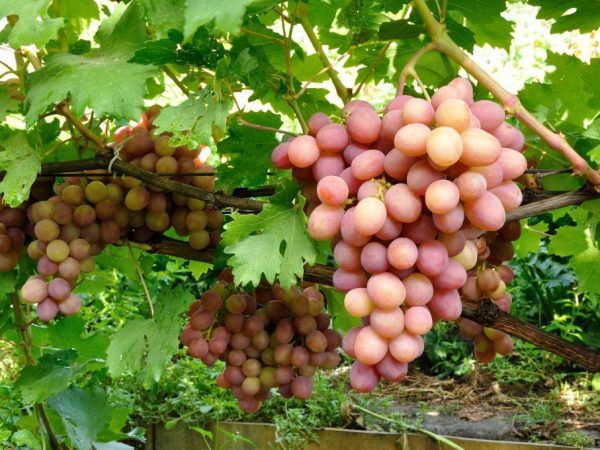Growing grapes Bohemia
Bohemia table grapes belong to the crops of Ukrainian selection. This is a hybrid that was created by crossing the varieties Millennium and Normal Mallow. It retains the virtues of each progenitor, which is why it is so popular.

Growing grapes Bohemia
Variety parameters
The Bohemian grape belongs to the early varieties. It begins to ripen in early August. Active fruiting is observed 2 years after planting. According to the description, the growing season lasts only 110 days from the moment of flowering.
Description of the bush
The bushes are characterized by small growth, only 2-2.5 m. Flowers are bisexual, which significantly increases productivity indicators.
Leaves are oval, 5 lobes. On the outside there are small white stripes, while on the inside there is a slight waxy coating and rough areas. The color of the leaf plate is dark green. The vine is powerful, dense. The flowers are white. Antennae are often located on shoots.
The main signs of the fetus
Bunches of Bohemian grapes reach a weight of 600 g. They are cylindrical in shape, with wide areas at the base. Berries are medium in size. Their length is only 2 cm, and their weight is 20 g. The rind is dense, opaque. A small waxy coating is noted on its surface.
The fruits are sweet, although after 2-3 years, ascorbic acid begins to appear in their composition, giving the taste a piquancy. The aroma is nutmeg, pleasant.
Growing recommendations
The Bohemian grape variety is capable of bearing fruit, regardless of the light. Landing is allowed both in sunny areas and in shaded areas. It is preferable to stick to planting in lighted areas of the garden, as this speeds up the process of fruit ripening.
The soil should be nutritious (black soil or loamy soil), with a low acid-base level. Under the condition of a high concentration of acidity, liming is carried out. For 1 sq. m, up to 3 kg of lime is introduced, evenly distributing it throughout the entire site.
When choosing a seedling, take into account the following features:
- the height of the planting material must be at least 1 m;
- the root system must be developed and have a length of 20-25 cm;
- near the root neck, there should be a trace of the vaccine, which is done to strengthen the immune system;
- the entire area of the seedling should be free of any damaged areas or signs of parasite exposure.
Prepare the landing hole in advance. Its depth is 60 cm, and its width is 80 cm. It is better to dig it out in early October. 10 kg of crushed stone and 4 kg of humus or peat are poured inside. During the winter, all nutrients will be absorbed into the ground, which will enhance the nutritional value of the soil.

The quality of watering is important for the plant.
A drainage system is needed to protect the roots from rot, since excess moisture, combined with the sun's rays, negatively affects the condition of the bush: the growth and fruiting of the culture slows down.
A small hill is made on top of the drainage system, into which the seedling is planted.The roots are leveled over the entire surface of the hole and carefully covered with an upper fertile layer of earth.
Nearby, at a distance of 5 cm from the hole, a metal rod is dropped in, which acts as a support for the bush. The distance between the bushes should be 3 m, and the row spacing should be about 4 cm.
Crop care procedure
Caring for Boheme grapes is simple. The quality of watering is important. It is carried out when there is no scorching sun, otherwise it leads to root rot and the complete destruction of the entire bush. Each plant has 25 liters of warm water. The irrigation interval is 15 days.
The further harvest depends on the quality of the dressing. The first fertilization is carried out 3 years after planting. In the spring, 2 kg of humus are applied at the root to saturate the soil with nutrients. In early July, the plant is saturated with a solution of potassium nitrate (30 g per 5 l of water) to accelerate the growth process. 15 days before the expected harvest, a solution of ammonium nitrate is introduced (60 g per 5 l of water). This improves the quality of the crop. In the fall, in the middle of October, a mixture of organic matter and mineral components is introduced under the root. 2 kg of humus and 50 mg of superphosphate are poured under each bush.
Pruning is carried out in the summer, after flowering. Remove all shoots that are out of the general structure of the bush. Remove most, leaving only 5-8 eyes on each. Dry diseased areas are also removed, which take over all the nutrients and prevent the plant from developing.
Pest and disease control
The Bohemian grape variety is resistant to most diseases. It is affected only by powdery mildew, olive spot and fruit rot.
A solution of Bordeaux liquid (3 g per 5 liters of water) helps to get rid of powdery mildew. You can permanently destroy olive stain with a solution of copper sulfate (30 g per 7 liters of water). Onion peel tincture helps from fruit rot (200 g is infused in 5 liters of water during the day).
Of the pests, the presence of fleas and ticks is noted. Flea beetles are fought with a manganese solution, which is prepared in the ratio of 3 g of the drug to 3 liters of water. An effective remedy for ticks is considered to be a tincture of cayenne pepper (30 g per 10 liters of water). Treatment against pests and diseases is carried out at intervals of 15 days until the culture is completely cured.
Conclusion
The Bohemian grape variety needs full care. If you follow all the recommendations, after 2 years you will be able to grow delicious high-quality products.


